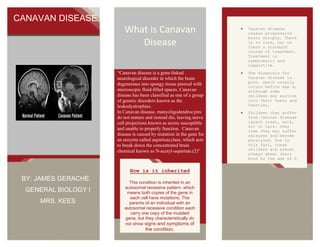
Canavan disease (1)
- 1. CANAVAN DISEASE What is Canavan Disease Canavan disease causes progressive brain atrophy. There is no cure, nor is there a standard course of treatment. Treatment is symptomatic and supportive. “Canavan disease is a gene-linked neurological disorder in which the brain degenerates into spongy tissue pierced with microscopic fluid-filled spaces. Canavan disease has been classified as one of a group of genetic disorders known as the leukodystrophies. In Canavan disease, manyoligodendrocytes do not mature and instead die, leaving nerve cell projections known as axons susceptible and unable to properly function. Canavan disease is caused by mutation in the gene for an enzyme called aspartoacylase, which acts to break down the concentrated brain chemical known as N-acetyl-aspartate.(2)” The diagnosis for Canavan disease is poor. Death usually occurs before age 4, although some children may survive into their teens and twenties. How is it inherited BY: JAMES GERACHE GENERAL BIOLOGY I MRS. KEES This condition is inherited in an autosomal recessive pattern, which means both copies of the gene in each cell have mutations. The parents of an individual with an autosomal recessive condition each carry one copy of the mutated gene, but they characteristically do not show signs and symptoms of the condition. Children that suffer from Canavan disease cannot crawl, walk, sit or talk. Over time they may suffer seizures and become paralyzed. Due to this fact, these children are almost always wheel chair bond by the age of 2.
- 2. Resource Page 1. http://www.canavanfoundation.org/about_canavan_disease 2. http://ghr.nlm.nih.gov/condition/canavan-disease 3. http://www.medicinenet.com/canavan_disease/article.htm
- 3. SUBHEAD HERE Delete box or continue brochure text here.Brief words or customer testimony. Delete box or continue brochure text here. Brief words or customer testimony. Delete box or continue brochure texthere. Delete box or continue brochure text here.Brief words or customer testimony. Delete box or continue brochure text here. Brief words or customer testimony.
